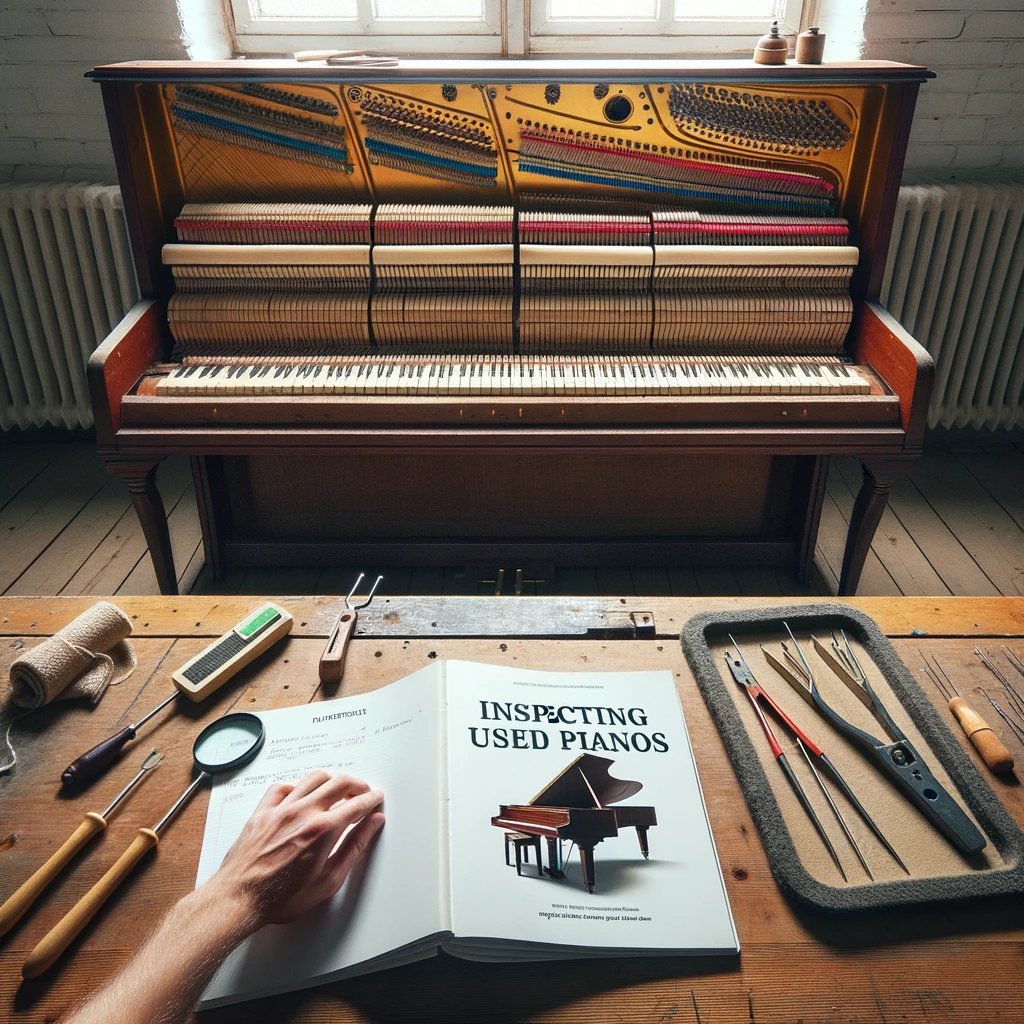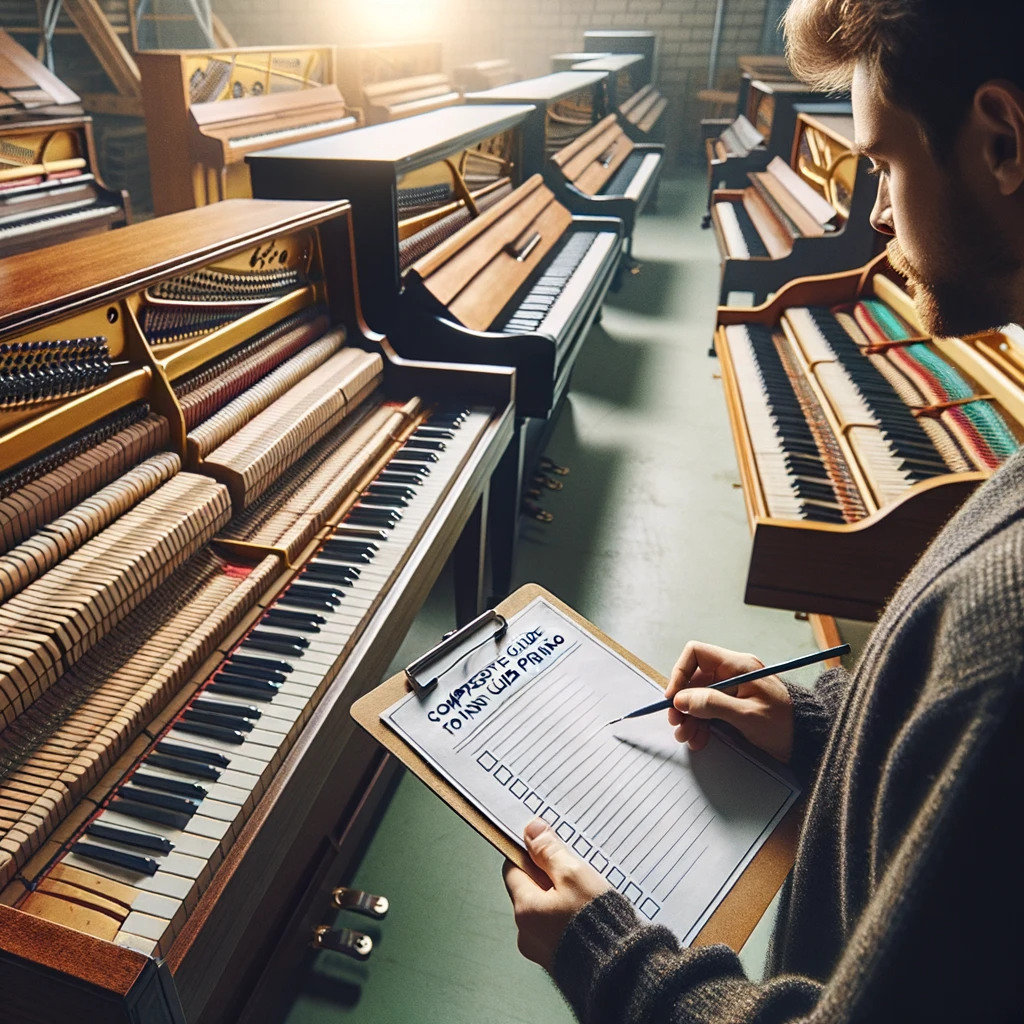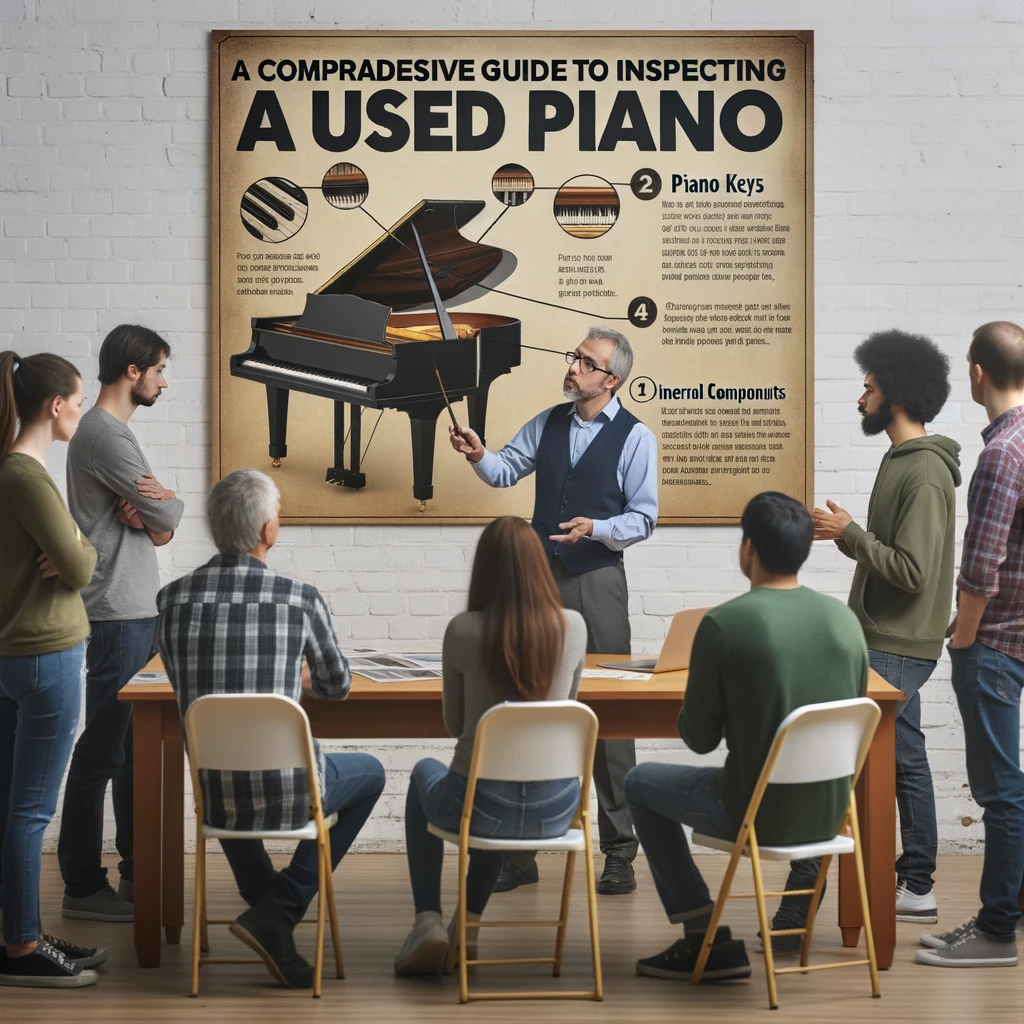Introduction

Inspecting a used piano is crucial before making a purchase. Purchasing a used piano can offer numerous advantages. The inspection process provides an overview of the piano’s condition.
The Importance of inspecting a used piano

Inspecting a used piano is essential to ensure that it meets your needs and expectations. A thorough inspection allows you to identify any potential issues or damage that may affect the piano’s performance or longevity.
By examining the piano closely, you can make an informed decision and avoid purchasing a faulty instrument. Additionally, inspecting a used piano helps to determine if it requires any repairs or maintenance.
It enables you to assess the expenses involved in restoring the instrument to its optimal condition, helping you make budgetary decisions accordingly. Proper inspection safeguards your investment and ensures you are getting value for your money.
The Benefits of purchasing a used piano

Purchasing a used piano offers several advantages, including affordability and unique character. Used pianos are often more reasonably priced compared to new ones, allowing you to acquire a high-quality instrument at a lower cost.
This makes them an excellent choice for beginners or those on a limited budget. Furthermore, used pianos often possess inherent beauty and character that develops over time with age.
They tend to exhibit warm tones and unique sound qualities that may not be present in newer models. This adds charm and personality to your playing experience, creating an instrument with its own rich history and story.
An Overview of the inspection process
The inspection process involves thoroughly examining various aspects of the used piano before finalizing your purchase decision. It includes assessing both external and internal components as well as mechanical functionality.
Externally, you should visually inspect the piano’s cabinet and keys. Look for any scratches, dents, or discoloration on the cabinet, and examine each key for cracks or chips.
Additionally, check the responsiveness and smooth movement of each key. Internally, inspect the soundboard for cracks or splits and tap various areas to listen for buzzing or rattling sounds.
Check the strings for rusting or breakage and ensure they are properly aligned. Evaluate the action mechanism by examining hammers, dampers, and other parts for wear and tear.
Mechanically, assess the tuning pins to ensure they are tight and functional. Test each pedal individually to confirm their smooth operation without resistance.
Exterior Inspection
General visual assessment
Look for scratches, dents, or discoloration on the cabinet. Check carefully along the edges and corners of the piano to ensure there are no visible damages that may affect its overall appearance.
Pay attention to any noticeable imperfections that could indicate rough handling or poor maintenance over time. These blemishes may not only affect the aesthetic appeal but also potentially indicate more significant issues.
Check for any signs of water damage or warping. Inspect all surfaces of the piano, including the top, sides, and back panel, for any indication of water exposure.
Look for discolored areas or signs of warping in the wood that might suggest water damage. Water damage can compromise the structural integrity of a piano and can lead to problems such as mold growth or weakening of the wooden components.
Key inspection
Examine each key for cracks, chips, or unevenness. Carefully inspect each individual key on the keyboard to identify any visible damage.
Look for cracks in both black and white keys, check for chipped edges or corners, and ensure there are no irregularities in their shape or alignment. Any noticeable defects could affect playability and require repairs.
Test the responsiveness and smoothness of each key’s movement. Press down on every key gently and observe how it responds – it should depress smoothly without any hesitation or sticking sensations.
Move your fingers across different keys quickly to assess if they respond evenly with consistent resistance. A well-maintained piano will typically have keys that move freely without feeling sluggish or producing unwanted sounds like squeaks or clicks when played at different speeds.
Interior Inspection
Soundboard Examination: Uncovering Hidden Damage
Inspect soundboard for cracks or splits. Tap different areas to listen for buzzing or rattling sounds. The soundboard, a crucial component of a piano, can suffer damage that is not immediately visible.
By carefully inspecting the soundboard, you can uncover any cracks or splits that may impact the instrument’s sound quality. Look closely for any signs of damage and run your fingers along the surface to feel for irregularities.
Additionally, tap various areas of the soundboard and listen attentively for any buzzing or rattling sounds. These anomalies may indicate underlying issues that require further attention.
String Inspection: Ensuring Optimal Performance
Check strings for rust or breakage. Ensure proper alignment and spacing between strings. Examining the strings is an essential part of inspecting a used piano.
Look closely at each string to check for signs of rust, which can negatively affect both tone and longevity. Make sure there are no broken strings as well.
Furthermore, verify that all strings are properly aligned and not touching each other; this ensures optimal vibration and resonance throughout the instrument. By paying careful attention to these details, you can ensure that the piano’s string system is in good condition and capable of producing high-quality sound.
Action Mechanism Evaluation: Assessing Precision and Responsiveness
Examine hammers, dampers, and other action parts for wear and tear. Test action by playing keys at different velocities.
The action mechanism plays a vital role in determining how well a piano responds to touch. Inspect all action parts, including hammers and dampers, meticulously searching for any signs of wear or tear such as felt deterioration or broken components.
Test the action’s precision by playing different keys at varying velocities—observe how well it responds to light touches as well as stronger strikes. Ensuring that the action mechanism is in optimal condition guarantees that the piano will deliver consistent and accurate sound production based on the player’s touch.
Mechanical Inspection
Ensuring Optimal Performance
1. Check tuning pins tightness:
– Assess if the tuning pins are tight and hold their position well.
– Verify that the pins are not loose or wobbly, as this could affect the stability of the piano’s tuning.
2. Look for signs of previous repairs or loose pins:
– Examine each tuning pin carefully for any signs of repair work, such as glue residue or visible alterations.
– Be vigilant for loose pins that may cause the strings to go out of tune easily or result in unexpected tonal variations.
Pedal Functionality Evaluation
Adding Expression to Your Music
1. Test each pedal individually:
– Evaluate the functionality of each pedal by stepping on them one at a time.
– Observe if they respond smoothly and without any excessive squeaking or resistance.
2. Verify proper engagement and disengagement:
– Ensure that each pedal engages and disengages without any difficulty or unexpected resistance.
– Pay attention to any unusual noises or sensations when operating the pedals, as this could indicate underlying mechanical issues.
Remember, a thorough mechanical inspection is crucial since it directly affects how enjoyable your playing experience will be. By examining the tuning pins’ condition and checking pedal functionality, you can ensure optimal performance and maintain control over your instrument’s tonality while creating expressive music.
Additional Considerations
Hire a professional technician
Engage a qualified piano technician to conduct an in-depth inspection. The expertise of a professional can provide valuable insights into the condition of the used piano. A technician will have the knowledge and experience to identify subtle issues that an untrained eye might miss.
Suggest engaging a qualified piano technician to conduct an in-depth inspection
By seeking the services of a qualified piano technician, you can ensure that your investment is well-protected. A thorough inspection by a professional will provide you with an accurate assessment of the instrument’s overall condition. Their expertise allows them to identify potential problems and estimate any necessary repairs or maintenance costs accurately.
Conclusion
Inspecting a used piano before making a purchase is crucial for ensuring that you get an instrument in good condition. By following these guidelines and engaging a qualified piano technician, you can make an informed decision about whether it meets your needs and requirements.
Remember, investing time and effort in inspecting a used piano now can save you from costly repairs or disappointments later on. With careful consideration and expert assistance, you can find a quality used piano that brings joy and beautiful music into your life for years to come.